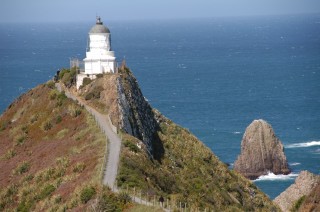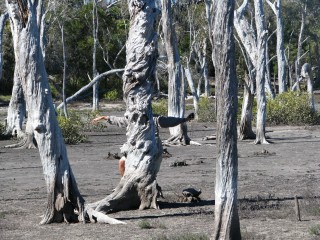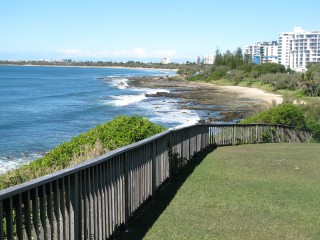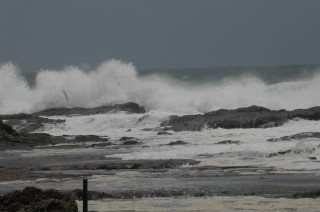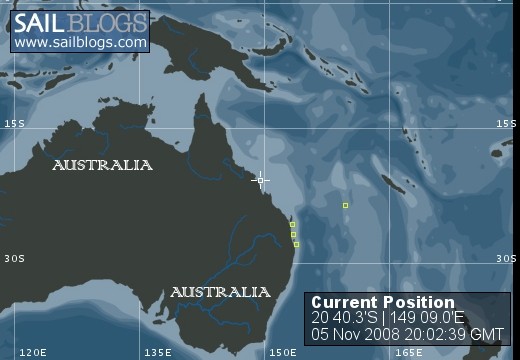
Silkie's Journal
05 November 2008
07 September 2008
02 August 2008 | Queensland, AU
17 May 2008 | Lat 27 48'S; Long 153 26'E
26 October 2007 | Lat 23 24'S Long 159 19'E
01 September 2007 | Lat 13 17'S Long 163 54'W
01 July 2007 | Lat 17 34'S Long 149 37'W
11 May 2007 | Lat 0 45'S Long 90 18'W
13 April 2007 | Lat 08 56'N, Long 79 33'W
24 March 2007 | Lat 09 19'N, Long 80 00'W
11 February 2007 | Lat 15 50'N, Long 88 44' W
Anchored Near Taina Marina, Papeete, Tahiti
01 July 2007 | Lat 17 34'S Long 149 37'W
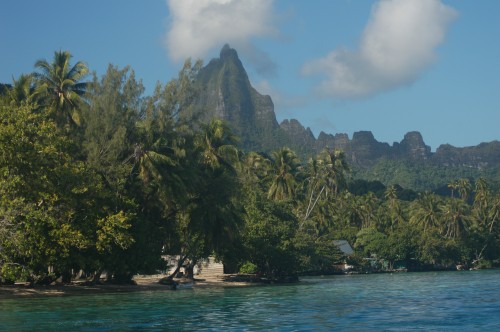
The last report found us three days out of Santa Cruz Island in the Galapagos, headed WSW to the Marquesas Islands in French Polynesia. We were having a delightful sail on a very big and very empty ocean. That general description continued for the next 18 days, it taking us a total of 21 days to cover the 3055 nm distance between Galapagos and Hiva Oa in the Marquesas. It was all downwind sailing and after the first week or so we essentially put away the mainsail for good and proceeded quite successfully under jib alone or jib and staysail wing on wing. The winds gradually increased as we got further west and south and we had several long stretches with 18-21 knot winds. Silkie did beautifully. We did not set any speed records. For a while, I kept track of our daily progress by recording the "trip log" on the Furuno chartplotter. The results for those 9 days are as follows: 166, 150, 140, 140, 141, 140, 148, 140, and 140 nm. So what's with the 140? We were in a rut! A fellow cruiser suggested that we had found our "comfort zone" and I expect that is correct. What we might make over that during the day we lost at night when we reduced sail. Hey, this was not a race. We enjoyed every day of the trip, even on the last few days as the "smell of the barn" got stronger and stronger.
We did experiment with the asymmetric spinnaker we had on board, left over from two boats back. It is a little small for a boat this size, which suited me just fine. We had at least five days of sailing it in light winds for at least a few hours each day, then disaster struck: we could not get it down soon enough as 8-11 knot winds quickly (and briefly as it turns out) rose to 15-17 knots. We had trouble spilling the wind, the sail flew out horizontally and the throat of the sock got stuck high up on the pulley mechanism so that John could not pull it down. We ended up dropping the thing in the water and, wonder of wonders, were able to retrieve it from the water without hurting it or ourselves or getting it snagged on a prop or anything else under the boat. The future of the asymmetric remains up in the air at this time.
During the crossing we saw whales (off in the distance, thankfully), several large schools of porpoise (hard to count but they covered a very large area of the ocean, I'm guessing greater then 50-75 animals easily), a large long fish (4 feet+ long at least) that jumped several times perhaps trying to rid itself of parasites, two separate factory ships way off in the distance that lit up the sky with their lights, and the most amazing stars we have every seen. There was one sight, however, we could have done without. As we left the Galapagos and passed the Island of Isabella, being at least 4-5 nm offshore, we noticed several wasps flying around the mainsail which had been stowed and covered for the length of our stay in Santa Cruz. We thought they had built a nest in the sail and would be gone as soon as we raised the sail. Much to our surprise we saw more and more of them all around the back of the boat and (horrors!) could see them flying in from behind as we motored along at 6-7 knots. The "several" quickly turned into 10s and then hundreds of wasps all over the back of the boat. Thankfully they were not aggressive and their sting, which I'm sure was accidental, hurt for only a moment. As we watched them we decided they were more interested in making love then war and surmised that we passed through a large swarm that had lost its way and used us as a "port in the storm". By the third day they were mostly gone, having flown off or succumbed to our flyswatter. Turns out that we were not the only boat to experience this: Madhatter, a few miles behind us, witnessed the same thing. During the whole 21 days we actually saw only one cruiser as we passed him in the dark. He turned on his nav lights when he saw our lights and we talked to him on VHF. A soon as we went by he turned off his lights to conserve power and immediately "disappeared." We never saw him on radar. We also talked to several other cruisers on SSB radio and had a daily check in on frequency 8188 that lasted for about a week. After that we kept up with three other boats ahead of us with daily emails over the sat phone giving our position and general well-being. It was very nice to be able to communicate with others doing the same thing and going the same way.
But all good things come to an end and on June 2 we arrived at Hiva Oa in the Marquesas. We timed our arrival for about an hour after sunrise and sure enough the sun rose on time and the fog burned off to reveal the picture post-card drop dead gorgeous South Pacific Island we all know and love from those coffee table books. From the cruisers perspective, the reality fell a little short of the fantasy. The harbor at Hiva Oa is small for the number of boats there and only partially protected by a breakwater. The holding is excellent but boats are crowded and must put out stern anchors to stay bow-to the swell and away from other boats. The dingy dock is a concrete hunk, slippery, small, no handholds and subject to surge. Dingys need a stern anchor to keep them off the dock. The town and the gendarmerie where you check in is a good 50 minute walk around the bay. There are two decent stores, prices are very high for some things (e.g. dozen eggs 500 cfp; large peanut butter 985 cfp; a box of cereal, 843 cfp) and low for others (e.g. 1 lb. excellent canned New Zealand butter, 215 cfp; a quart of UHT milk, 134 cfp), where 85cfp=$1US. All alcohol is extremely expensive. A bottle of poor quality vodka cost about $80US. The town on Hiva Oa, Atuona, has about 1500 people, is absolutely clean, neat and tidy. The houses are in good repair and attractive. The people are well fed and the vehicles are all late model small trucks. There is little indication of economic activity and we could not see how they supported themselves. Our next stop, Taiohae Bay on the island of Nuku Hiva, was very similar. We concluded that the islands must be subsidized and a French couple who had lived in the islands for the last 13 years told us that those subsidies came from France in a big way.
Taiohae Bay on Nuku Hiva, was a very pleasant anchorage. The bay is large, holding good, the swell is not too bad, there is lots of room for the boats to spread out. Again, the dingy dock was difficult. We got the distinct impression that despite the fact that lots of cruisers come through the Marquesas (and drop their money here), there is no incentive to provide safe facilities for them. Maybe that's because they would come anyway. We spent over a week at Taiohae Bay and found the two decent food markets, went to the Saturday market at 4:00 AM (!!!) where we bought beautiful local fresh produce, went on a driving tour of the island in a Land Rover (the vehicle of choice) and were greatly impressed with the road-building skills of the locals. There is beauty everywhere you look on this island but there is a distinct paucity of flat land for homes or agriculture.
Coconuts are really big here as are bananas (five different kinds), the most delicious grapefruit you've ever eaten, oranges, papaya and untold other tropical fruits.
The next stop on the way to Tahiti was the Tuomotu (this word is the plural, no "s" required), about 490 nm SW, where we stopped at Manihi and Rangiroa. Rangiroa is the second largest atoll in the world, measuring about 45 by 18 nm, a veritable inland sea which can generate 2 m waves when the wind kicks up. This was our first experience with passes where you need to pay attention to the state of the sea outside, the tides and the direction of the current in the pass since these passes can run quite fast (up to 8 knots max in Tiputa Pass, Rangiroa). We timed our arrivals and departures with these considerations in mind and had no problems. Our paper charts were WORTHLESS at these places and the electronic charts were not much better so it we navigated in the lagoon visually. The depth in the lagoon (at least where we went) was 80-100 feet and the shallow places stood out clearly as bright light-green spots in a sea of deep blue. We spend three nights in Manihi and four in Rangiroa. We will always remember Rangiroa since both of us were sick as dogs. Thankfully, the holding was good, the wind blew through the boat and it was a delightful temperature. Food was not a problem since we didn't eat anything at all!
But again, all good things come to an end and we left Rangiroa for Tahiti, doing the 190 nm run over two nights so as to arrive at dawn outside Papeete Pass. The problem was to go slow enough that we came out even since 190 is too far to cover in one night considering when we could get through the pass in Rangiroa, but too close to make an honest two day run.
We are presently anchored near the Taina Marina on the NW side of the island in 55 feet of water behind the reef, with the wind blowing 18-25. Our initial thought was to go into the Taina Marina and tie up but they had no room when we arrived. Turns out to be a good thing. They do not have slips. All boats are Med moored, i.e. backed up to the dock and held off by anchor and other lines that go from bow to large blocks on the bottom. Soon after we arrived and were anchored, the winds shifted from E to SSE, exposing the anchorage area wind and water over the reef. We are doing fine, although I find this a little nerve wracking, but the boats med moored to the outside of the marina (with their sterns within 5 feet of the cement dock) are exposed to the wind and chop and are having a time of it. This is an unusual wind situation and will end soon -or at least will end sometime- at which time we will partake of the joys of Tahiti. We got just a taste of the good life here on our first day when we made one trip to the Carrefour market (read Publix) and saw great cheese, great pastries, great meat, all of it very expensive but available. But more of that next time.
'Till then
Susan on Silkie.
We did experiment with the asymmetric spinnaker we had on board, left over from two boats back. It is a little small for a boat this size, which suited me just fine. We had at least five days of sailing it in light winds for at least a few hours each day, then disaster struck: we could not get it down soon enough as 8-11 knot winds quickly (and briefly as it turns out) rose to 15-17 knots. We had trouble spilling the wind, the sail flew out horizontally and the throat of the sock got stuck high up on the pulley mechanism so that John could not pull it down. We ended up dropping the thing in the water and, wonder of wonders, were able to retrieve it from the water without hurting it or ourselves or getting it snagged on a prop or anything else under the boat. The future of the asymmetric remains up in the air at this time.
During the crossing we saw whales (off in the distance, thankfully), several large schools of porpoise (hard to count but they covered a very large area of the ocean, I'm guessing greater then 50-75 animals easily), a large long fish (4 feet+ long at least) that jumped several times perhaps trying to rid itself of parasites, two separate factory ships way off in the distance that lit up the sky with their lights, and the most amazing stars we have every seen. There was one sight, however, we could have done without. As we left the Galapagos and passed the Island of Isabella, being at least 4-5 nm offshore, we noticed several wasps flying around the mainsail which had been stowed and covered for the length of our stay in Santa Cruz. We thought they had built a nest in the sail and would be gone as soon as we raised the sail. Much to our surprise we saw more and more of them all around the back of the boat and (horrors!) could see them flying in from behind as we motored along at 6-7 knots. The "several" quickly turned into 10s and then hundreds of wasps all over the back of the boat. Thankfully they were not aggressive and their sting, which I'm sure was accidental, hurt for only a moment. As we watched them we decided they were more interested in making love then war and surmised that we passed through a large swarm that had lost its way and used us as a "port in the storm". By the third day they were mostly gone, having flown off or succumbed to our flyswatter. Turns out that we were not the only boat to experience this: Madhatter, a few miles behind us, witnessed the same thing. During the whole 21 days we actually saw only one cruiser as we passed him in the dark. He turned on his nav lights when he saw our lights and we talked to him on VHF. A soon as we went by he turned off his lights to conserve power and immediately "disappeared." We never saw him on radar. We also talked to several other cruisers on SSB radio and had a daily check in on frequency 8188 that lasted for about a week. After that we kept up with three other boats ahead of us with daily emails over the sat phone giving our position and general well-being. It was very nice to be able to communicate with others doing the same thing and going the same way.
But all good things come to an end and on June 2 we arrived at Hiva Oa in the Marquesas. We timed our arrival for about an hour after sunrise and sure enough the sun rose on time and the fog burned off to reveal the picture post-card drop dead gorgeous South Pacific Island we all know and love from those coffee table books. From the cruisers perspective, the reality fell a little short of the fantasy. The harbor at Hiva Oa is small for the number of boats there and only partially protected by a breakwater. The holding is excellent but boats are crowded and must put out stern anchors to stay bow-to the swell and away from other boats. The dingy dock is a concrete hunk, slippery, small, no handholds and subject to surge. Dingys need a stern anchor to keep them off the dock. The town and the gendarmerie where you check in is a good 50 minute walk around the bay. There are two decent stores, prices are very high for some things (e.g. dozen eggs 500 cfp; large peanut butter 985 cfp; a box of cereal, 843 cfp) and low for others (e.g. 1 lb. excellent canned New Zealand butter, 215 cfp; a quart of UHT milk, 134 cfp), where 85cfp=$1US. All alcohol is extremely expensive. A bottle of poor quality vodka cost about $80US. The town on Hiva Oa, Atuona, has about 1500 people, is absolutely clean, neat and tidy. The houses are in good repair and attractive. The people are well fed and the vehicles are all late model small trucks. There is little indication of economic activity and we could not see how they supported themselves. Our next stop, Taiohae Bay on the island of Nuku Hiva, was very similar. We concluded that the islands must be subsidized and a French couple who had lived in the islands for the last 13 years told us that those subsidies came from France in a big way.
Taiohae Bay on Nuku Hiva, was a very pleasant anchorage. The bay is large, holding good, the swell is not too bad, there is lots of room for the boats to spread out. Again, the dingy dock was difficult. We got the distinct impression that despite the fact that lots of cruisers come through the Marquesas (and drop their money here), there is no incentive to provide safe facilities for them. Maybe that's because they would come anyway. We spent over a week at Taiohae Bay and found the two decent food markets, went to the Saturday market at 4:00 AM (!!!) where we bought beautiful local fresh produce, went on a driving tour of the island in a Land Rover (the vehicle of choice) and were greatly impressed with the road-building skills of the locals. There is beauty everywhere you look on this island but there is a distinct paucity of flat land for homes or agriculture.
Coconuts are really big here as are bananas (five different kinds), the most delicious grapefruit you've ever eaten, oranges, papaya and untold other tropical fruits.
The next stop on the way to Tahiti was the Tuomotu (this word is the plural, no "s" required), about 490 nm SW, where we stopped at Manihi and Rangiroa. Rangiroa is the second largest atoll in the world, measuring about 45 by 18 nm, a veritable inland sea which can generate 2 m waves when the wind kicks up. This was our first experience with passes where you need to pay attention to the state of the sea outside, the tides and the direction of the current in the pass since these passes can run quite fast (up to 8 knots max in Tiputa Pass, Rangiroa). We timed our arrivals and departures with these considerations in mind and had no problems. Our paper charts were WORTHLESS at these places and the electronic charts were not much better so it we navigated in the lagoon visually. The depth in the lagoon (at least where we went) was 80-100 feet and the shallow places stood out clearly as bright light-green spots in a sea of deep blue. We spend three nights in Manihi and four in Rangiroa. We will always remember Rangiroa since both of us were sick as dogs. Thankfully, the holding was good, the wind blew through the boat and it was a delightful temperature. Food was not a problem since we didn't eat anything at all!
But again, all good things come to an end and we left Rangiroa for Tahiti, doing the 190 nm run over two nights so as to arrive at dawn outside Papeete Pass. The problem was to go slow enough that we came out even since 190 is too far to cover in one night considering when we could get through the pass in Rangiroa, but too close to make an honest two day run.
We are presently anchored near the Taina Marina on the NW side of the island in 55 feet of water behind the reef, with the wind blowing 18-25. Our initial thought was to go into the Taina Marina and tie up but they had no room when we arrived. Turns out to be a good thing. They do not have slips. All boats are Med moored, i.e. backed up to the dock and held off by anchor and other lines that go from bow to large blocks on the bottom. Soon after we arrived and were anchored, the winds shifted from E to SSE, exposing the anchorage area wind and water over the reef. We are doing fine, although I find this a little nerve wracking, but the boats med moored to the outside of the marina (with their sterns within 5 feet of the cement dock) are exposed to the wind and chop and are having a time of it. This is an unusual wind situation and will end soon -or at least will end sometime- at which time we will partake of the joys of Tahiti. We got just a taste of the good life here on our first day when we made one trip to the Carrefour market (read Publix) and saw great cheese, great pastries, great meat, all of it very expensive but available. But more of that next time.
'Till then
Susan on Silkie.
Comments
| Vessel Name: | Silkie |
| Vessel Make/Model: | CW54 Catamaran |
| Hailing Port: | Oriental, North Carolina |
| Crew: | Susan and John Fisher |
Silkie at Nuku Hiva
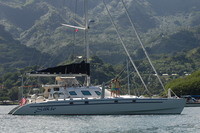
Who: Susan and John Fisher
Port: Oriental, North Carolina
Current Position
Favorite Links
No Links Added Yet
